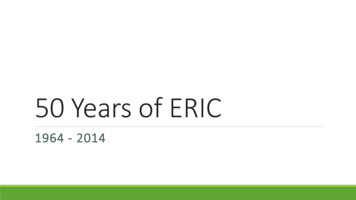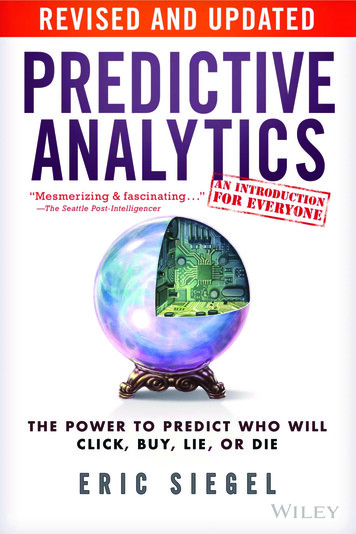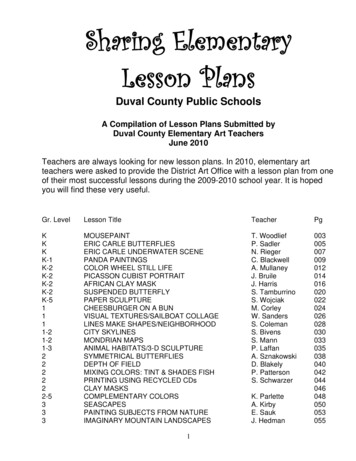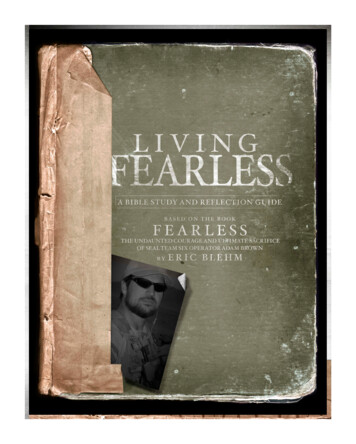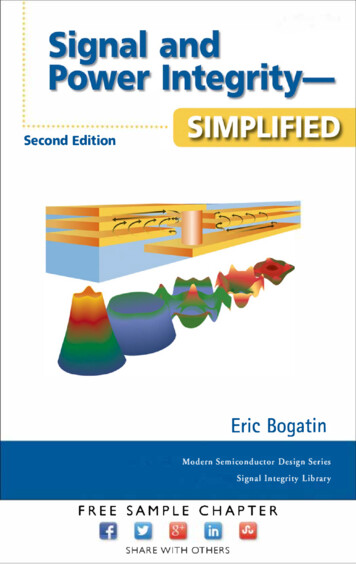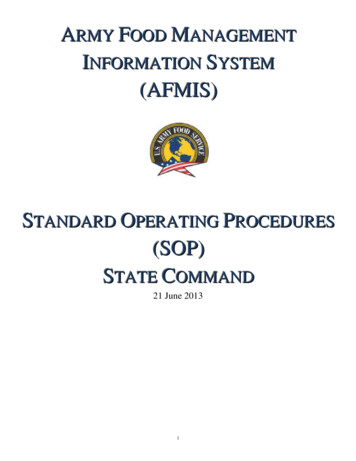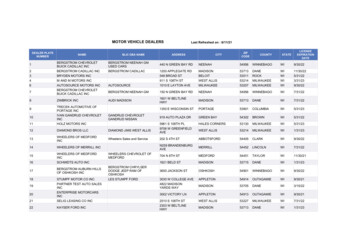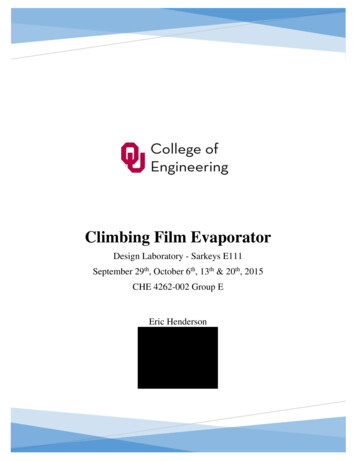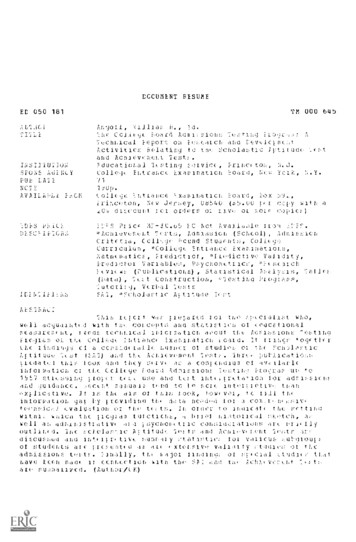
Transcription
ECCUMENT BISUAETM 000 845ED 050 181CcILE(jc7(2chhical PeporT,ctiviticsh., Id.A(1(11:sionTostrhqi-:.:caich (Inc r,.ivIclmc;,11:7cholaL-.tic 4.ta(udeand Acnic-vi.tFducatioLal.1.1210:10.;SFONA6INLYPUL LAal.NCT'AVAILiH,LiColledt:Ltivic(, PrincutoL,N.J.EhtfaLc Exarination Hoard,711'2Up.iLttaLGE '7x,:pLat1oL Loard,iri%ceton, Niw J(-727:,ey,U6541)SPt is c1Nct,C c 11or 5o :b.vai.la.iie\rtrt -1.t.Critcopy with a(.:(5.UUdirccurt tor orders or LivI riyit(ScLcol) ,C undStuurnts,CO 1(topic:),t(WhiEsicjCUI:r CILIUM, tC0.1.1(. "EttraLccT-redicticr, *Irdictiv(:, Validity,Variab1.2:7, P:ycnomctrics,(PuLlicatiohs), Statistical ;').11yEis,Construction, ,v'icstiho(i)ata),';utcrii(j, VcrFal4Sc3,olast1c 4titude 7F c t1(LE1Fli(C:icictt vas 1.let,arE d 101 th0 spi.ciatli;t who,well acyuaint(A toith tllt cotc(Tt::, anci stc.tif:tic5 of (:(7tdcEtional'o.stinomEa:3arc,:(nt, teccIE tcleh1.1Cd1 1v1or7c.tich aocut th(, AcHisionat triLcs 1-octIcrtai,:.Ltranc( Ixa5iLatio,tiA Coll;rqcf a ccp: ,Ld(ratlf: IARDCI 01thELitituuu 1(stthlS ICON111101rOdtlei, C;studio::: Oi'Ii(tLt AcLicvomoLtthcy oLiv( a:: a COMIEliG1UU et A'1,11af1(trc Ccltcye foat.:(1711:E1on:use andlor.,(:ctLt PaLuai: u,tql tc 1c rcIE intor;letiv(: thanth( alit olLoc(k, tows vol, tc(--xi licative. It101 A C0111Hintorii,atroL dal Ny (rovidin IL(IL ()roc:: to iLoicat( the scttinovalua1ion ct 'HA i.1.01.ilird.Au 1dto-1 ,litE.INC I1C7d0111],-ALi.;totical !Kotch, 3,-all isycno(Jttic 1,7)1i1;1(1,1011S 6F(.OUtlit(1. 11,EAl-titudc, -Jolts and Ach1(,v(tAlit io:;tsttatistic: tel vaticusdir cusbud aLd intirtr(tivi, su5La1 ya:: at(of :;tudLts aic(.xtorsiv(.? valiaity :-tattle; of thcth( hajoradmiEElousat spcial : tudits hattug 1-.ch1vcrkt.tn thoLavo tcLn FiA0c it ccnkt,;(-1(11(.011atE,a:, 6(11-,11,3Etl,,tivi
eICOCD14-1PERHT55I0N 10 REPRF 01./Ci 1HiS COPfRIGR7E.) MAlEPIAL SY MICROFICHE CINLYHAS SEEN CRANlEJ weLijU)n) 0 FTO ERIC 0,0 OR, RN 2 1i ORS ORERAIINGH 11-E LOS 0;F CEOF FOL,CAT OR FL RI HER 17cRPODJ(11014C' DER 0,,RE EMCNTS 1r4SYSTEM RF121.1 111, PERDE1-E ER014 JF 101 COPYRIGHT OF1YERThe College Board Admissions Testing Program:A technical report on research and development activitiesrelating to the Scholastic Aptitude Testand Achievement TestsWilliam H. AngoffEditorC.)OCOLLEGE ENTRANCE EXAMINATION 110AIII), NEW YORK, 1971
Cepie3 of this book may be ordered from:Publications Order OfficeCollege Hot rail( e Extruiliation BoardBox 592, Princeton, Nov JerF.ey ai510The line is 5 per copy, with a discount of 20 percentfor orders of five or more co;lies.This book was prepared and produced for the CollegeBoard by Educational Testing Service.Copyright (0 1971 by College Entrance ExaminationBoard. All rights reserved. Library of Congress CatalogNumber 75-150163. Printed in the t1mted States ofAmerica.
ContentsForewordPrefaceChapter I. The Admissions Test;ng ProgramWILLIAM II. ANDOFF and HENRY S. DYERHistorical backgroundAdministrative considerationsNature of the programAdministration of the testsInfluence on curriculum14456CoachingSecurity7.Psy,bornetric considerationsValidity.eliabitityParallelism of formsItem analysis.Test analysisThe score scaleThe normsScoring methodsReferences.889910101113Chapter II. The S'ehotastir Aptitude TestTHOMAti F. DONLON and WILLIAM H. ANGOFFThe purpose of the SAT15A description of the current testiiistory and evolution of the SAT17Assembly of the SA k-verbal sectionsAssembly of the sAT-rn.ithernatical sectionsGeneral comments on the assembly21The pretest program261923253
Chapter II (CONTINUED)Parallelism and reliability of the SATValidity28Speed ed ness29Correlation between skr-verbal and sAT- mathematical scoresFactor analyses of the SATOrigin and maintenance of tne FAT score scaleCurrent procedures and their resultsThe 800-scoreScore changeCoachingPreliminary Scholastic Aptitude Test (Pskr)Arrangements for handicapped studentsReferences3028323235404145454646ChaAfer III. The Achierement TestsWILLIAM E. COFFMANIntroductionPurpose,Historical backgroundEvolution of the Achievement Testing Pi ogra mTesting datesConstruction proceduresThe committee systemTest planningCurriculum bias in the Achievement TestsThe quality control systemScaling and equating the Achievement TestsEstablishing the initial scaleEquating subsequent formsStatistical characteristics of the Achievement ge Board CatalidatcsChapter IV. Deseriptire Statisticsand Other Reference Cro!psW. B. SCIand E. ELIZABETH KrEwARTIntroductionUses of descriptive statistics on test performanceScore interpretationGroup comparisonsMethodological considerations47979797979
Performance on the sATHigh school senior and college freshman normsLocal normsCandidate norms, 1967-68 and 196C-69Trends in candidate performancePerformance on Achievement, TestsNature of Achievement Test candidatesCharacteristics of groups taking specific testsCandidate norms, 1967-68 and 1968-69Trends in candidate 09115Chapter V. The Predictive Validity of College Board ildiKissions Tc-tW. B. SCHRAi)ERIntroductionThe role of predictive validity in the development and usa ofCollege Board testsDesigning conventional regression studiesChoice of criterionChoice of groupsChoice of predictorsStatistical analysis.Reporting the resultsInterpreting the resultsDesigning validity studies for special purposesComparison of alternative predictorsPlacement useInterpreting validity coefficients at a measure of predictive value .Evidence on the predicti:e validity of the SATResults for students in liberal arts and general programsResults for students in special curriculums or divisionsValidity for foreign students at tending college in the United StatesEvidence on the predictive validity of the Achievement TestsPrediction of freshman average gradePrediction of grades in courses or subjectsCentral prediction: Efforts to improve or facilitate prediction forgroups of 2123124125127130132135135138139144Chapter VI. S:Iceial StudiesJOHN FREMERMt11LJOR1E O. CHAND1 ERIntroductionEffects of coachingCoaching in independent preparatory schoolsCoaching relatively less able students147147148149
Chapter VI (CONTINUED)Practice and growthProblems in the explanation of score changesSummaries of score changesContribution of practice and growth to score changesUse of retest scores in predictionStudents view their performanceFatigue and anxietyOpinions of students and school officialsEffect of fatigue on test scoresEffects of anxiety on test scoresAppropriateness of a single SATConsideration of new item types for the SATNew item types fot predicting four-year performanceValidity of new item types for high-aptitude studentsValidity of new item types at various ability levelsNew test contentBiographical InventoryTests of Developed AbilityAcademic Interest IndexItI)ers-Briggs Type IndicatorFormulating Hypotheses TestEnglish essayOpinions of teachers and students on essay testingThe first objective English Composition Test exerciseThe Interlinear exerciseComparison of six item typesThe General Composition TestThe Writing SampleThe new English Composition Test essayPoints of view in essay gradingSpecial populationsSex differencesCultural differencesSAT scores at tie extremes of the score rangeCurriculum change and diversityImpact of new physics curriculumsDifferent cognitive approachesAchievement in chemistryCulver Military Academy: A case studyA look 1681701721741751761761771781781.11;150150150
Figures and TablesChapter IIFigure 2.1 Sample SAT instructionsFigure 2.2 Genealogical chart for SAT-verbalFigure 2.3 Genealogical chart for SAT-mathematical.Figure 2.4 Illustration of highly consistent equating resultsFigure 2.5 Illustration of marginally acceptable equating results18Table 2.1 Data relating to speededness: sAT-verbal sectionsTable 2.2 Data relating to speededness: sAT-mathematical sectionsTable 2.3 Item types used in svr-verbal and SAT-mathematical sections,2020Table 2.4Table 2.5Table 2.6Table 2.7343635391926-6921Classification scheme for sAT-verbal itemsDistributions of SAT-verbal items by difficulty level.Distributions of sAT-mathematical item by difficulty levelDistribution of equated deltas for sAT-verbal and SATmathematical items at time of pretest: 1965-6622Table 2.8 Internal-consisteacy reliability estimates and standard errorsof measurement for 12 recent SAT formsTable 2.9 Estimates of parallel-form reliability for SAT scoresTable 2.10 Scaled score equivalents to selected raw scores for eightSAT forrasDecember 1967 to May 1969Table 2.11 Percent completing the test for 12 SAT forms December1966 to May 1939Table 2.12 Percent completing three quarters of the test for 12 SATformsDecember 196G to May 1969Table 2.13 Mean and standard deviation of the number not reached for12 SAT forms December 1966 to May 1969212527282929303031Table 2.14 Correlation bet weeo sAT-verbal and sAT-mathematical scoresfor 12 formsDecember 196G to May 1969Table 2.15 Trend in the correlation between sAT-verbal scores andsAT-mathematical scoresTable 2.16 Maximum scaled scores obtained with linear equating foreight SAT forms-1961.66Table 2.17 Specified distributions of item difficulties and :neon biserialsfor the SATLiximurn set led scores obtained with linear cwating for fourSAT formsDecember 1966 to May 1967Table 2.19 Maximum scaled scores obtained with linear equating foreight SAT forms- -December 1967 to May 196931314041Table f'.1841427
Chapter II (CONTINUED)Table 2.20 Seven-year summary of change in sAT-verbal scores fromMarch or May of the junior year to December or Januaryof the senior yearTable 2.21 Seven-year summary of change in sAT-mathematical scoresfrom March or May of the junior year to December or Januaryof the senior year4344Chapter IIITable 3.1 Example of a test outline for an Achievement Test(Social Studie3)Examplesof item analysis computer outputTable 3.2Table 3.3 Example of score distributions and conversion data reportedin test analyses of Achievement Tests (Physics Test, May 1963)Table 3.4 Example ol data on reliability, intercorrelations of sections,and speededness of sections re:arted in test analyses ofAchievement Tests (Physics Test, May 1933)Table 3.5 Example of detailed data on speededness reported in testanalyses of Achievement. Tests (Physics Test, May 1963,"tniditional" sample)Table 3.6 Example of detailed data on speededness reported in testanalyses of Achievement Tests (Physics Test, May 1963,6063646566PSSC sample)Table 3.7 Example of item analysis summary data reported in testanalyses of Achievement Tests (Physics Test, May 1063).Table 3.8 Summary statistics for English, Social Studies, Science, andMathematics Achievement Tests for candidates taking both theSAT and the Achievement Tests in 1968-69Table 3.9 Summary statistics for language Achievement Tests forcandidates taking both the SAT and the Achievement Testsin 1968-69676970Tabl, 3.10 Example of scatterplot form used to record item date forAchievement TestsTable 3.11 Specified and actual item statistics for Achievement Testsadministered in May 1967 and January 1963Table 3.12 Numbers of items (n), reliability estimatesstandardand indexes of speedednesserrors of measurement (SE,,,(a,b,c) for Achievement Tests administered in May :',967at.d January 1968Table 3.13 Reliability coefficients, multiple correlation coefficients, andestimates of three different proportions of variance ofAchievement Test scores for samples of candidates taking theSAT and Achievement Tests in 1968-69viiiK5672737576
Chapier. 111Figure 4.1 Attendance of twelfth-grade students at SAT sessions, 1956-57through 1968-69Figure 4.2 Ratio of number of SATS taken by twelfth-grade students tonumber of births 18 years earlier, 1956-57 through 1968-69.Figure 4.3 Attendance of twelfth-grade students at Achievement Tests.ssions, 1956-57 through 1968-69Figure 4.4 Percentage of Achievement. Tests administered in five subjectmatter categories, 1956-57 through 1968-69Table 4.1Table 4.2Table 4.3Table 4.4Table 4.5Scholastic Aptitude Test means and standard deviations for aAim:al sample of secondary school seniors tested in 1960,ry sec and academic status in 1960-61sAT- verbal and SAT-mathematical mean scores for applicants,accepted applicants, and enrolled students reported by 18collet -s in the Manual of Freshman Class Profiles of 1962.1964. and 196567Numbers cf colleges in which changes of various amountsoccurred in percentile ranks for selected scaled scores b'tweenthe 1963 edition and the 1965-67 edition of the Manual ofFreshman Class ProfilesMeans, standard deviations, and numbns of ScholasticAptitude Test scores, classified by candidate's sex andeducational level, 1967-68 and 1968-69Means, standard deviations, and numbers of cases (inthousands) for all candidates taking the SAT, by year,1956-57 through 1965 -69909193111838")888992Table 4.6 Percentages of Achievement Test candidates taking the varioustests at !east once during the last two years of secondary school 94Table 4.7 Scholastic Aptitude 'rest means and standard deviations for95Achievement Test candidatesTable 4.8 Percentages of Achievement. Test candidates tested in thejunior year, senior year, or both years, by specific96Achievement TestTable 4.9 Means, standard deviations, and numbers of AchievementTest scores, classified by to t and by candidate's sex ant'educational level, 1967-68 and 1968-6997Table 4.10 Mean differences in Achievement Teot scores earned by boys100and girls. 1%7-68 and 1963-69Table 4.11 Mean differences in Achievement Test scores earned by juniors101and seniors, 1967.68 and 1968.69Table 4.12 Means, standard deviations, and numbers of scorn- onAchievement Tests in foreign languages, classified by test andby candidate's sex, educational level, and number of semestersof study of the language in secondaiy school, 1967.68 and1968-691029
Chapter IV ((70N7 'NUMTable 4.13 Mean differences in Achievement Test scores in foreignlanguages earned by candidates with different amounts of107language study, 1967-68 and 1968-69Table 4.14 Means, standard deviations,, and numbers of scores onAchievement, Tests in mathematics, classified by test. and bycandidate's sex, educational level, and number of semesters ofstudy of secondary school mathematics, 1967-68 and 1968-69108Table 4.15 Mean differences in Mathematics Level I Achievement Testscores earned by candidates wtita different amounts of110mathematics study, 1967-68 and 1968-69Table 4.16 Percentages of Achievement Tests administered in fivesubject-matter categories, by year, 1956-57 through 1968.69. 110'fable 4.17 Volumes for specific Achievement Tests expressed aspercentages of total Achievement. Test volumes, by year,1121956-57 through 1968.69'fable 4.18 Attendance at Achievement Test Losions, classified by113candidate's educational level, 1956-57 and 1968-69Table 4.19 Means, standard deviations, and numbers of cases (inthousands) for all candidates taking Achievement Tests,113by year, 1956-57 through 1968-69Chat,:. VTable 5.1 Correlation coefficients of selected faculty ratings with generalTable 5.2Table 5.'Table 5.4Table 5.5Table 5.6desirability rating and with first-year gradesExample of expectancy table prepared by Ile College BoardValidity Study ServiceExample of scatter diagram prepared by the College BoardValidity Study ServiceRange of correlation coefficients that would be expected toinclude 95 percent of ohserved values for selected populationvalues and sample sizesRelation between standing on predictor and standing oncriterion for various values of the correlative coefficientValidity coefficients of sAT and high school record: selectedpercentiles of validity coefficients based on students in liberalarts and general programs classified by sexTable 5.7 Validity coefficients of SAT and high school record: selei tetipercentiles of validity coefficients based on students in liberalarts and general programs classified by level of verbalability and by sexTable 5.8 Validity coefficients of SAT and high school record: selectedpercentiles of validity coefficients based on students in li'seralarts and general programs classified by homogeneity of verbalalJility and by ex122123125126127128129.r10120
Table 5.9 Validity coefficients of SAT and high school record: frequencydistributions and selected percentiles of validity coefficientsbase i on liberal arts and general groups classified by131homogeneity in verbal abilityTable 5.10 Validity coefficients of SAT and high school record: results for133engineering, science, and architecture groupsTable 5.11 Val dity coefficients of SAT and high school record: results for134bus:ness, education, and other groupsTable 5.12 EffIxt on multiple correlation cu-fficient of using AchievementTest scores with SAT and high school records for predictingfirst-term or first-year grades: women in liberal arts and136general programsTable 5.13 EPect on multiple correlation coefficient of using AchievementTest scores with SAT and high school record for predicting firsttei m or first-year grades: men in liberal arts and general137programs and engineering studentsTable 5.14 E feet on multiple correlation coefficient of using AchievementTest scores with sAT and high school record for pre3ic.ingfist-term or first-year average grades: various stud ant groups 138Table 5.15 Correlation coefficients of SAT-V, English Coinposit'On Test,140a Id high school record with English gradesTable 5.16 Correlation coefficients of sAT-M, Mathematics AchievementTests, and high school record with freshman matherlatics grades. 141Table 5.17 Correlation coefficients of SAT, Science and MathematicsAchievement Tests, and high schcol record with science grades. 142Table 5.18 Correlation coefficients 6, SAT-V, foreign language Achievement'I'ests, and high school record with foreign language grades. 143Table 5.19 Correlation coefficients of SAT, Social Studies Achievement143Test, and high school record with social studies gr idesChapter l'AThole 6.1Relative achievement of the CH A, CI1EM, and control groupsthree tests in chemistry177
ForewordThe College Entrance Examination Board has long since ceased to be engagedsolely with examinations, and the examinations it now sponsors are not all concernedwith college entrance. It is not surprising, however, that in the minds of many, theCollege Board is associated with "the College Boards"the Scholastic AptitudeTest and the Achievement Testswhich constitute the Board's AdmissionsTesting ProgramThis program, t largest by far of the Board's testing programs, has entered thelives of over a million students in each recent year, affecting the decisions made byhundreds of cclleges and the counseling services offered in thousands of schools. Itis natural that a program involving so many interests should have given rise tomany questions about its nature and value. The Board is indebted to Educational Testing Service (ETS), which administers the Admissions Testing Program,for providing in this book information that will answer questions about the moretechnical aspects of the program.It is a genuine pleasure for me, on behalf of the College Board, to thank mycolleagues on the staff of ETS who worked so hard and well to assemble and reportthese facts about the Scholastic Aptitude Test and Achievement Tests. I am keenlyaware of the special burdens that William Angoff has borne as editor, and sharewith all who were involved in the project admiration and appreciation for the graceand skill with which he brought the project to completion.The publication appears at a time when changes in the Board's testing programsare in the wind, some of them stimulated by the work and report of the Commissionon Tests, appointed in 1967 by Richard Pearson, former President of the Board,to review all of the Board's existing examinations. gather evidence of the need forchange, and consider what tests 'ray be needed a decade hence." This book showsthat significant changes have taken place time after time in the Board's collegeentrance tests, and it is fair to assume that further changes may well be necessaryif the program is to continue to fit the reds of col'iges, schools, and students. Theresourcefulness and talent underlying the techniques described in this book offerpromise that the best possible efforts will be brought to bear on the development ofwhatever new tests and techniques the needs of the future demand.Job/ A, Valoft(neCollege Entrance Examination BoardSeptember 197012
PrefaceThis repo,t, was prepared for the specialist who needs technical information aboutthe Admissions Testing Program of the College Entrance Examination Board. Itbrings together the findings of a considerable number of studies of the ScholasticAptitude Test (sAT) and the Achievement Tests. It assumes a reader fairly wellacquainted with the concepts and statistics of educational rreasurement.Three publications might be considered the book's predecessors: College BoardScores, Their Use and Interpretation, No, 1, published in 1953; College Board Scores,Their Use and Interpretation, No. 2, published in 1955; and 1957 Supplement toCollege Board Scores, No. 2. These publications are a compendium of availableinformation on the College Board Admissions Testipl Program up to 1957. Thepresent book occasionally refers to the earlier documents, but focuses mainly onmore recent data.The emphasis of this book is also somewhat different from that of its predecessors.The earlier publications were, in a sense, "how to do it" books. Their purpose wasto describe how the tests might properly be used in admissions and guidance andto provide data needed for interpreting the test scores. To a considerable extent,this function 1ms been taken over by College Board Score &ports: A Guide forCounselors and Ad missions Officers, which is revised annually and widely distributed.Mention should also be made of the computation manual, Predicting College Grades,published in 1961, and the Manual of Freshman Class Profiles, which was publisheduntil 1969, when it was incorporated in The College Handbook.These progeny of the old us,:r-andinterpretation books retain some of the "howto do it" emphasis of their ancestors, but tend to be mor interpretive than explicative. They do not, however, provide all the data needed for a comprehensivetechnical evaluation of the tests. The aim of this book is to fill that gap.The Board's Admissions Testing Program must respond effectively to a varietyof unique and complex demands, In order to indicate the setting within which thegrogram operates, the first chapter describes the program as a wholeits history,how it is organized, the unique demands it faces, and technic 11 inc,t ters involved inits operation that arise from the demands.The second chapter discusses the SAT, the third is about tl.e Achi vemerit Tests.The fcurth chapter interprets summary statist ics for various aubgroups of students,and the fifth reports on some of I he extensive validity studies of the admissionstests. The sixth and final charter summarizes the major findings of special studiesthat have been made in connection with the SAT and the Aciievernent Tests.Although there k quite properly. an interrelationship Z1/110114 the topics coveredin the various chapters. the drainers were written independently with the relentthat .arch would stand as an integral unit, containing all the ni,.terial relevant to itHowever, since some material, especially that having to do with technical pro13
cedures, has relevance to more than one chapter, there is inevitably some repetitionacross chapters.The authors were chosen for their special competence in the subject of theirchapters, but the book as a whole is the product of many other persons, most ofwhom are connected in one way or another with the Admissions Testing Program.In fact, the contributors include a substantial number of the staff members of theCollege Board and Educational Testing Service, and for this reason it would bepractically impossible to list them in this preface for the credit they richly merit.Especially 1.elpful were those individuals who served with me on the review com-mittee, some of whom were also chapter authors: William E. Coffman, John M.Duggan, Henry S. Dyer, William B. Schrader, Robert J. Solomon, and John A.Valentine.Additionally, the following members of the College Board Committee of Examiners in Aptitude Testing were of great aid in reviewing chapters in manuscript form:Carl t3ereiter, Frederick 13. Davis, John R. Hills, Julian C. Stanley (Chairman),Warren S. Torgerson, and Dean K. Whit la. A special debt, of gratitude is owed toDavid E. Loye for his able editorial ass:stance and to the staff of the ETS publicationsdivision for coordinating publication of the book.The Admissions Testing Program i3 revised continually to meet changing con-ditions,. Thus, it can be expected that this book, which describes the program,will be revised as necessary to report new developments in the program and toreflect the results of research on new as well as old problems.Witham If. AngoffEdLcational Testing ServiceSeptember 1970y111
(.:} Ii' FF,1 tThe Admissions Testing ProgramWILLIAM H. ANOOFF and HENRY S. DYERhistorical bockgroundThe College Entrance Examination Board was organized during a meeting held at Columbia University inNew York on November 17, 1900. The move culminated efforts over several years in this direction bythe Association of Colleges and Preparatory Schools ofthe INfiddle States and Maryland, and a number ofeducators in the East, notably Nicholas Murray Butlerof Columbia and Charles W. Eliot of Harvard. Theevent was, according to the Board's first historian, thefirst (organized "attempt to introduce law and olderinto an educational anarchy which toward the dos:, ofthe ninetecitli century had become exasverating, indeed intolerable, to sehoolamsters." tFuess, 1950, p. I)*At this time there was, in the opinion of the foundersthat a system of examinations of this sort would effectmarked savings of time, money, and effort in a(""ministering college admissions, that it would greatly aid thework of the secondary schools by reducing confusionand easing the strain on students, and that it wouldrepresent a cooperative effort of a group of colleges andsecondary schools to achieve a set of common goalswithout asking the colleges to surrender their prerogatives as to the particular examinations they requiredof their applicants or the manlier in which they mightwish to select their students.It is important to recognize that the examinationswere secondary to the main purpose of the Board,which was to provide a channel of communication be-of the Board, appallingly little agreement among thetween the schools and colleges and to encourage a degroe of uniformity in the secondary school curriculum.On the other hand, it is more tlian likely that these pur-colleges about the types of subject - matter pmpariotionand E tandards of proficiency required of the applicants.instrumentality of the examination system which, uponOne headmaster, for example, complained that out ofacceptance by the colleges as a way of setting standards,40 it r so boys preparing for college in his school, he had,effectively paved the way for the introduction of uni-in reality, more than 20 different classes. The effect ofform curriculums in the schools.this odiversity on the secondary schools was to make thetask of preparing their students for college an extremelydifficult one, cod made the task of the student whq wasIn its first year of op ertion the College Board heldessay examinations in nine subjects: English, French,German, Lit in, Greek, history, mathemat irs, chemistry,and physics. The definition of the requirements in eachsubject tatas taken from the recommendation of theprofessional association in each subject-matter area.not ,ure which college he hoped to attend difficult andconfusing as well.lio its atter Ipt then, to accomplish its 'impose andintroduce an order into the transition from school tocollege, the College Board established the beginningsof a system of syllabi or "course requirements" onposes would never have been achieved without theThe substance of tetath examination was then c'etcrminedby a carefully selected committee of examiners. consisting of well-known teachers and scholars in the lead-which schools and colleges could agree, and which mighting colleges and secondary sc.lools in the East, who metform the basis of a system of examinations offering theto confer on the gt neral content and structure of theunVormity that was so badly needed. That is to say,the examinations would be unicorn, in subject natterand uniformly administered at unolorm times, but heldexaminations and to decide on the specific questions tobe asked. After extensive preparation, the first exam-in many places to meet the convenience of tlic students,June 17, 1901, to 973 candidates at 69 testing centers.and they would be uniformly graded. It was expectedThus, although the Board was as yet far from Iing anational institution-75S of the 973 candidatel wereseeking admission to either Columbia or Barnardit*1' le authors wish to acknowledge e.-si,tanee i ro% hicd byti c outline, and, in many instanots, the particular pt, usingu,ed in Dr. Yuess*excellent oc FS kw ei the lion .crs history.They also wish to acknowledge the in% aluabie enures of int.( rmatk.n provided by the Culkge Board's Annual Reports.inations were finally cdmmistered during the week ofwas at luasi -a going operation with the beginnings of amechanism for continuation.As with the committees ( f examiners, committees ofreaders were also chosen with care. These committees,
one in each subject, were assembled in the ColumbiaUniversity Library and graded i he papers in accordancewith a proce
Table 2.3 Item types used in svr-verbal and SAT-mathematical sections, 1926-69. 21. Table 2.4 Classification scheme for sAT-verbal items. 22. Table 2.5 Distributions of SAT-verbal items by difficulty level. 21. Table 2.6 Distributions of sAT-mathematical item by difficulty level. 25. Table 2.7 Distribution of equated deltas for sAT-verbal and SAT-
